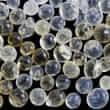Background
- Silicon is the second-most abundant element in the earth's crust, after oxygen. It binds to oxygen, forming crystalline or amorphous silica (silicon dioxide, SiO2), silicic acid (Si(OH)4), and silicates, such as quartz. Silicon is present in rocks, soil, sand, and dust as crystalline silica. Silicic acid is formed naturally from silica and is readily absorbed in the human gastrointestinal tract.
- Silicon is an ultratrace element, meaning that it is suspected as being required in quantities of less than 1 milligram, but is associated with no known essential role in biological processes. A recommended dietary allowance (RDA) or adequate intake (AI) has not been established for silicon.
- In the diet, silicon is found mainly in drinking water and plant-based foods, such as beer, unrefined grains (oats, barley, rice, and wheat bran), fruits, vegetables (spinach), and beans (red lentils).
- Silicon is included as silicates in cosmetic and pharmaceutical preparations. Silicates are also added to processed foods and beverages, where they serve as anticaking agents, thickeners, and stabilizers, and they are used as clarifying agents in beer and wine.
- Silicon is biocompatible and has been used in many implantable medical devices, including pacemakers, defibrillators, stents, materials for plastic and reconstructive surgery (including breast implants and bone grafts), devices for sustained-release delivery of drugs, sheeting (to treat and prevent the formation of scars following surgery), and liner sockets, or sleeves (to attach prostheses after amputation).
- Although researchers have examined the use of silicon for various purposes, its use for reducing aluminum toxicity associated with Alzheimer's disease is controversial. Some evidence suggests that silicon may be essential in humans for bone growth and health and development of other tissues in the body. High-quality scientific evidence supporting the use of silicon to treat any condition in humans is lacking.
References
- Baars EC, Geertzen JH. Literature review of the possible advantages of silicon liner socket use in trans-tibial prostheses. Prosthet Orthot Int 2005;29(1):27-37.
View Abstract - Brzezinski MB. Mining the diatom genome for the mechanism of biosilicification. Proc Natl Acad Sci U S A 2008;105(5):1391-2.
- Carlisle EM. A silicon requirement for normal skull formation in chicks. J Nutr 1980;110(2):352-9.
View Abstract - Carlisle EM. Biochemical and morphological changes associated with long bone abnormalities in silicon deficiency. J Nutr 1980;110(5):1046-56.
View Abstract - Carlisle EM, Curran MJ. Effect of dietary silicon and aluminum on silicon and aluminum levels in rat brain. Alzheimer Dis Assoc Disord 1987;1(2):83-9.
View Abstract - Domingo JL, Gómez M, Colomina MT. Oral silicon supplementation: an effective therapy for preventing oral aluminum absorption and retention in mammals. Nutr Rev 2011;69(1):41-51.
View Abstract - Exley C. Darwin, natural selection and the biological essentiality of aluminium and silicon. Trends Biochem Sci 2009;34(12):589-93.
View Abstract - Exley C. Silicon in life: whither biological silicification? Prog Mol Subcell Biol 2009;47:173-84.
View Abstract - Haddad FS, Kouyoumdjian A. Silica stones in humans. Urol Int 1986;41(1):70-6.
View Abstract - Jugdaohsingh R, Anderson SH, Tucker KL, et al. Dietary silicon intake and absorption. Am J Clin Nutr 2002;75:887-893.
View Abstract - Jugdaohsingh R. Silicon and bone health. J Nutr Health Aging 2007;11(2):99-110.
View Abstract - Nielsen FH. How should dietary guidance be given for mineral elements with beneficial actions or suspected of being essential? J Nutr 1996;126(9 Suppl):2377S-2385S.
View Abstract - Nawijn SE, van der Linde H, Emmelot CH, et al. Stump management after trans-tibial amputation: a systematic review. Prosthet Orthot Int 2005;29(1):13-26.
View Abstract - O'Brien L, Pandit A. Silicon gel sheeting for preventing and treating hypertrophic and keloid scars. Cochrane Database Syst Rev 2006;(1):CD003826.
View Abstract - Sripanyakorn S, Jugdaohsingh R, Dissayabutr W, et al. The comparative absorption of silicon from different foods and food supplements. Br J Nutr 2009;102(6):825-34.
View Abstract







